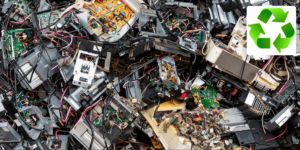
What Everybody Ought To Know About E-Waste Recycling
According to The Global E-waste Monitor, it is estimated that the annual amount of e-waste will exceed 74 million tonnes by 2030. The reason because yearly e-waste is gradually rising by 2 million tonnes per year.
This will have dire consequences if not appropriately controlled.
Any electrical equipment rendered unusable or at end-of-life and products that are not needed/wanted anymore are known as e-waste. These products include computer equipment, televisions, stereos, hard drives and etc. Electronic waste disposal is not something to be taken lightly, as it can be highly toxic to the environment if the e-waste is not correctly disposed of.
Table Of Contents
What Is E-Waste Recycling?
E-waste recycling refers to re-using or reprocessing electronic component waste materials to recover the valuable material that can be used in new electronic products. Since most electronics have a relatively short life, they tend to become e-wastes at a fast pace.
Another way of thinking about e-waste recycling is essential to properly dispose of these products to reduce the hazardous impact of e-waste on environmental health. E-waste recycling also helps conserve natural resources as well; the other main aim of recycling, other than protecting the environment from just being polluted with the landfill that could be recycled,… reducing global warming.
Recyclable Components Of E-waste
With the variety of electronic devices, their components vary significantly, as do the materials that must be considered before recycling. Therefore, the process of disassembling parts must be carefully conducted to optimise recycling for the effective reuse of materials in e-waste. These materials include but are not limited to plastic, metal, glass, mercury, various circuit board materials(commonly fibreglass, sometimes bakelite) and many more.
What Happens In The Recycling Process?
The e-waste recycling process varies according to the device and its components. However, all materials (such as metals, plastics and glass) must be separated at the end of the day. There is a general process that is followed for recycling electronic waste. The first stage involves collecting and transporting the e-waste components and material to the necessary facilities and plants.
At recycling plants, the waste is shredded and stockpiled for further sorting. Shredding involves the disintegration of e-waste into smaller pieces. Each base material then sorts these tiny pieces; so that the base material can be retrieved for eventual reuse after recycling. The materials are segregated into reusable materials and rubbish, as not all shredded material can be recovered as useful.
Once the dust from the shredding process is extracted, the magnetic separation process is next. The steel and iron are separated from the waste stream in this process. In contrast, water separation technology is used to separate glass and plastic. Lastly, the leftover metals are then located and extracted from plastics.
The recycling stage is concluded by preparing the materials for sale as raw materials. These materials will again be used to create new electronic components and other goods made with these materials.
The Australian Government has also made pick-up services available at designated points to make recycling more efficient for them and their agents. The Government has implemented various programs to facilitate the easy recovery of e-waste to encourage people and enlighten them about the importance of this practice.
E-waste Recycling Melbourne
Secure Hard Drive Destruction is the ideal choice for companies requiring E-waste recycling. We provide the most secure end-to-end disposal environment for e-waste recycling in Sydney and Melbourne. We offer multiple services to assist businesses with doing their part for the planet and also satisfy requirements for information security with on-demand and scheduled secure bin collection for paper and e-waste destruction and recycling.
Share It On :-
More Posts


Hard Drive Destruction vs. Data Wiping: Which Is More Secure?

The Benefits of Professional Shredding Services: Safeguarding Your Confidential Information

The Importance of E-Waste Management in Corporate Social Responsibility


